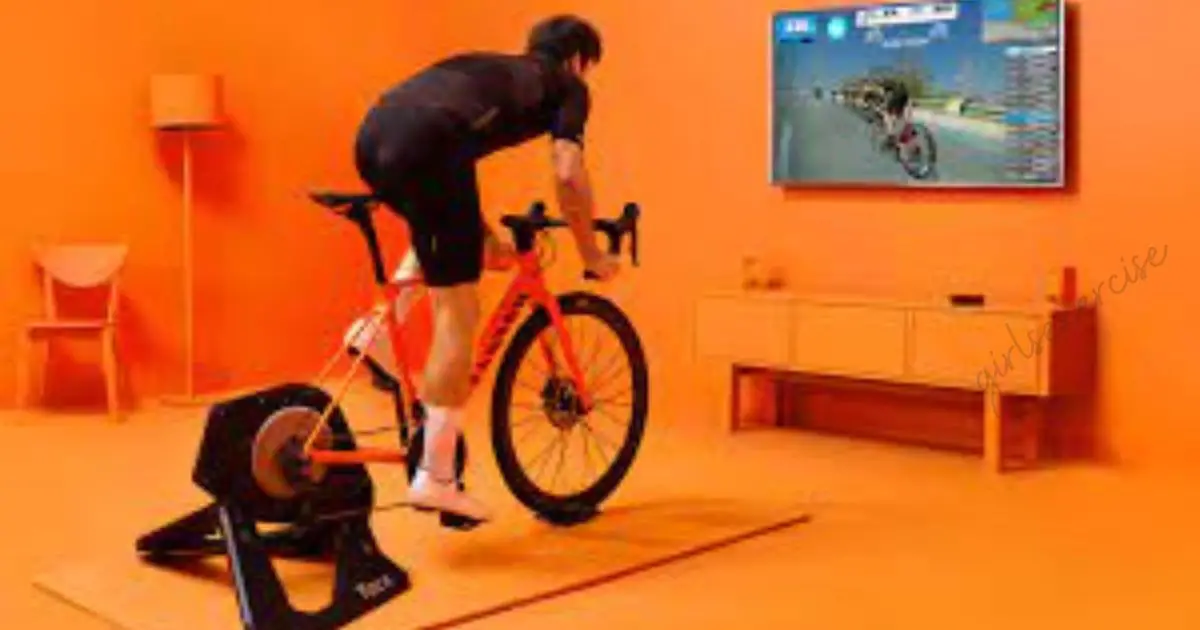Welcome to the exciting world of Zwift! If you’re wondering, “How does Zwift work?” you’re in the right place. Zwift is an innovative platform that combines the joy of indoor cycling with the social experience of a virtual community.
This remarkable application brings together fitness enthusiasts from around the globe, creating a dynamic and interactive environment that helps you stay motivated and reach your fitness goals.
Zwift is a sophisticated fitness app that allows you to connect your bike trainer or treadmill to your computer or mobile device. Wondering how Zwift works? Well, it uses cutting-edge technology to transform your workouts into immersive, gamified experiences.
You can pedal through breathtaking virtual landscapes, participate in group rides, and even join races, all from the comfort of your own home. Zwift makes exercise fun, engaging, and effective, whether you’re a seasoned athlete or just starting your fitness journey
The Mechanics of Zwift: How It All Comes Together

Before diving into the world of Zwift, it’s crucial to understand the mechanics that power this innovative platform. Zwift combines technology, gaming, and exercise science to create a dynamic and immersive experience.
Zwift’s Infrastructure:
At its core, Zwift relies on a complex infrastructure to facilitate the real-time connection of thousands of cyclists worldwide. Understanding how this infrastructure works can help you troubleshoot issues and appreciate the scale of the platform.
Server Network:
Zwift utilizes a network of servers to host virtual worlds and manage rider interactions. These servers are strategically distributed around the globe to ensure low latency for riders from different regions.
Cloud-Based System:
Zwift’s cloud-based architecture allows for continuous updates and improvements without requiring users to download large files. It also ensures data security and easy access from multiple devices.
Network Protocols:
Zwift employs specific network protocols to maintain a seamless experience. Learning about these protocols can be helpful for diagnosing connectivity issues.
User Accounts:
Each user has a personal account where their ride data and settings are stored. Understanding the relationship between your account and the Zwift world is essential.
Hardware Requirements:
To enjoy Zwift to its fullest, you need the right hardware. Here, we’ll outline the minimum requirements for your computer or mobile device, and discuss additional equipment that can enhance your experience.
Device Compatibility:
Zwift is available on various platforms, including Windows, macOS, iOS, and Android. We’ll explore which devices are compatible and discuss the differences in performance and graphics.
Smart Trainers: .
Smart trainers are a game-changer for Zwift. We’ll explain what they are, how they work, and the advantages they offer over traditional trainers.
Sensors:
Cadence sensors, heart rate monitors, and power meters provide critical data for your Zwift ride. We’ll detail the types of sensors available and how to set them up.
Additional Equipment:
Accessories like fans, trainer mats, and noise-reduction solutions can significantly improve your comfort and overall experience. We’ll guide you through choosing and using these accessories.
Getting Started with Zwift: The Basics
Now that you have an overview of the mechanics, let’s dive into the basic steps to start your Zwift journey. This section covers everything from creating your account to pairing your equipment.
Account Creation:
The first step in your Zwift adventure is creating an account. We’ll walk you through the registration process, including choosing an appropriate subscription plan that suits your needs.
Choosing a Subscription:
Zwift offers various subscription plans, including free and paid options. We’ll help you understand the differences and decide which plan is right for you.
Account Settings:
Your Zwift account is your virtual identity. We’ll explore how to customize your profile, add a profile picture, and manage your settings.
Software Installation:
With your account created, the next step is installing the Zwift app on your chosen device. We’ll break down the installation process and help you get up and running.
Downloading and Installing:
We’ll provide step-by-step instructions for downloading and installing the Zwift app on your computer or mobile device.
Logging In:
After installation, you’ll need to log in to your account. We’ll explain how to do this and ensure a smooth start to your Zwift journey.
Pairing Your Equipment:
To fully engage with Zwift, you must pair your equipment with the platform. This step is crucial for accurate data tracking and an immersive experience.
Bluetooth and ANT+:
Zwift supports both Bluetooth and ANT+ connections for pairing your equipment. We’ll clarify the differences between these technologies and help you choose the right one for your setup.
Pairing Your Trainer:
Connecting your smart trainer or traditional trainer is a fundamental step. We’ll guide you through the process and troubleshoot common pairing issues.
Additional Sensors:
Whether it’s cadence sensors, heart rate monitors, or power meters, pairing these sensors correctly ensures precise data during your rides. We’ll explain how to do it.
Choosing the Right Equipment for Your Zwift Setup:

The quality of your equipment is a pivotal factor in your Zwift experience. In this section, we’ll explore the options available and help you choose the gear that best suits your needs and budget.
Smart Trainers vs. Traditional Trainers:
Smart trainers and traditional trainers are the foundation of your Zwift setup. We’ll delve into the key differences and advantages of each to help you make an informed choice.
Smart Trainers:
These trainers offer real-time resistance adjustments and a more immersive experience. We’ll discuss the types of smart trainers, their benefits, and how to select the right one for your budget.
Traditional Trainers:
If you’re considering a traditional trainer, we’ll explain the various types and how to set them up for use with Zwift.
Additional Sensors:
Sensors play a crucial role in tracking your performance and providing data for Zwift’s virtual world. We’ll discuss the different types of sensors and their importance in your setup.
Cadence Sensors:
Cadence sensors monitor your pedaling rate, a valuable metric for efficient cycling. We’ll explain how to choose and install a cadence sensor.
Heart Rate Monitors:
Monitoring your heart rate is essential for effective training. We’ll guide you through selecting and pairing a heart rate monitor.
Power Meters:
Power meters provide accurate data on the power you’re generating while cycling. We’ll discuss the types of power meters and their significance in Zwift.
Accessories:
In addition to trainers and sensors, various accessories can enhance your Zwift experience. We’ll explore the most popular accessories and how they can improve your comfort and performance.
Fans:
Staying cool during intense rides is crucial. We’ll explain the benefits of using fans and how to position them effectively.
Mats:
Trainer mats protect your floors and reduce noise. We’ll discuss the importance of using a mat and how to choose the right one.
Noise Reduction Solutions:
Reducing noise from your trainer can make your Zwift sessions more enjoyable for you and your housemates. We’ll offer noise reduction tips and solutions.
Exploring the Zwift World: A Virtual Cycling Experience:

Zwift’s virtual world offers diverse landscapes and routes to explore, making your rides exciting and immersive.
Zwift Worlds:
Zwift features a variety of worlds that cater to different tastes and riding preferences. Here’s a look at some of the key Zwift worlds:
Watopia:
Watopia is Zwift’s fantasy island, offering diverse terrain, including beaches, mountains, and cityscapes. We’ll guide you through the wonders of Watopia and its various routes.
New York:
If you’re a fan of urban landscapes, New York’s futuristic city streets are sure to pique your interest. We’ll explore the routes and landmarks of this Zwift world.
London:
London brings the charm of the British capital to your virtual ride. We’ll discuss the landmarks and routes available in this city-themed world.
Innsbruck:
Nestled in the heart of the Austrian Alps, Innsbruck offers breathtaking mountain scenery. We’ll delve into the alpine routes and challenges in this world.
Routes and Courses
Within each Zwift world, you’ll find a multitude of routes and courses, catering to riders of various skill levels, interests, and ride durations. Here’s what you need to know:
Route Selection:
Choosing the right route is crucial for a satisfying Zwift experience. We’ll discuss how to navigate the route selection menu and explore the different categories of routes.
Scenic Routes:
Some riders prefer leisurely rides to soak in the virtual landscapes, while others seek more challenging climbs. We’ll introduce you to scenic and challenging routes and help you make the right choice.
Distance and Duration:
Zwift routes vary in terms of distance and duration. Whether you have 30 minutes or a few hours to ride, we’ll guide you in finding the ideal route.
Zwift PowerUps
PowerUps are a unique feature in Zwift, adding a strategic element to your rides. We’ll explain each PowerUp and when to use them to gain an advantage during workouts or races:
Types of PowerUps:
Zwift offers a variety of PowerUps, each with its own benefits. We’ll detail the PowerUp types, such as the Aero Boost and Burrito, and discuss their strategic use.
Obtaining PowerUps:
PowerUps are typically found in in-game events, like races and group rides. We’ll explain how to obtain and activate PowerUps during your rides.
Strategies for PowerUps:
Effective use of PowerUps can make a significant difference in your performance. We’ll provide strategies for when to use them for maximum impact.
Customizing Your Zwift Experience:

Personalization and Progress:
Personalization is key to making your Zwift experience unique. We’ll explore how you can customize your avatar and track your progress within the platform.
Avatar Customization:
Your virtual avatar represents you in the Zwift world, and customizing it allows you to express your individuality. We’ll cover the following aspects:
Clothing and Accessories:
Zwift offers a wide array of clothing and accessories to personalize your avatar. We’ll guide you in selecting the right gear to match your style.
Equipment Customization:
Beyond clothing, you can also customize your avatar’s equipment, such as bikes and wheels. We’ll discuss the available options and how to acquire them.
Ride-Ons and Encouragements:
The ride-on feature allows you to give virtual thumbs-up to other riders. We’ll explain how to use this feature and spread positive encouragement.
Progression and XP:
Zwift employs an Experience Points (XP) system to track your progress and unlock new features. Understanding how XP works is crucial for your Zwift journey:
Earning XP:
We’ll delve into the various methods for earning XP, such as completing routes, participating in events, and climbing the levels.
Unlockable Content:
Zwift rewards your progression with unlockable content, including new routes and equipment. We’ll detail what you can unlock and at what XP levels.
XP as a Measure of Achievement:

XP serves as a measure of achievement on Zwift. We’ll explore how it’s used to categorize riders and determine their experience levels.
Training Plans and Workouts:
Zwift is not just a virtual world to explore; it’s also a powerful tool for training and achieving your fitness goals. We’ll help you harness Zwift’s training features effectively:
Training Plans:
Zwift offers a range of training plans designed by expert coaches. We’ll guide you through selecting and following a training plan that suits your goals, whether it’s improving your endurance, speed, or strength.
Structured Workouts:
Structured workouts are an integral part of Zwift’s training system. We’ll explain how to access and complete these workouts, which are tailored to specific training objectives.
Custom Workouts:
If you have unique training needs, you can create custom workouts. We’ll provide instructions on how to design your own workouts within Zwift.
Training and Competing on Zwift: Achieving Your Fitness Goals:
Zwift’s dynamic environment offers a range of training options and opportunities to compete. This section will help you use the platform to meet your fitness goals.
Training Zones
Understanding training zones is crucial for structuring your workouts effectively. We’ll explain the concept of training zones and how to use them to tailor your training sessions:
Training Zone Basics:
We’ll break down the training zones, from Zone 1 (active recovery) to Zone 7 (sprint efforts), and describe the physiological responses associated with each.
Determining Your Zones:
Discover how to determine your personal training zones using methods like the FTP (Functional Threshold Power) test.
Structured Workouts in Zones:
Zwift’s structured workouts are designed with specific training zones in mind. We’ll explain how to select workouts that align with your training objectives.
Racing and Events
Zwift is not just for solo training; it’s a bustling platform for group rides, races, and events. Engaging in these activities can add excitement and motivation to your Zwift experience:
Racing on Zwift:
Zwift racing is highly competitive and offers a chance to challenge yourself against other riders. We’ll guide you on how to join races, understand race categories, and compete effectively.
Group Rides:
Group rides provide a more social and supportive environment for Zwifters. We’ll discuss how to join group rides, find rides that match your pace, and participate in charity events.
Event Calendar:
Zwift maintains an event calendar with a wide range of activities. We’ll explain how to navigate the calendar and find events that suit your interests and schedule.
Metrics and Analytics
Zwift provides a wealth of data and metrics during and after your rides, which are instrumental in monitoring your performance and making improvements:
Power Data:
Power data, measured in watts, is a key performance metric. We’ll explore how to interpret your power numbers and use them for training and racing.
Cadence and Pedaling Efficiency:
Cadence and pedaling efficiency play a crucial role in your cycling performance. We’ll discuss the ideal cadence ranges and techniques for efficient pedaling.
Heart Rate Monitoring:
Monitoring your heart rate provides insights into your cardiovascular performance. We’ll explain how to use heart rate data to optimize your training.
Social Aspects of Zwift: Connecting and Riding with Others:
Zwift is not just about the virtual roads; it’s a vibrant community of riders. Connecting with others and participating in group activities can be a motivating and enjoyable part of your Zwift experience.
Zwift Friends and Followings:
Building your social network on Zwift is an essential part of the experience. We’ll cover the following aspects:
Adding Friends:
Zwift can be easily used to send or receive friend requests.It could help us to increase our social relations with our love ones very quickly.
Following Other Riders:
Following other riders allows you to see their activities and join their rides or events. We’ll explain how to follow other Zwifters and build your network.
Privacy Settings:
Privacy settings are crucial for controlling who can see your activities. We’ll discuss how to adjust your privacy settings to suit your preferences.
Chat and Messaging
Communication is vital when riding with others on Zwift. We’ll explain how to use the chat and messaging features to interact with fellow Zwifters:
In-Game Chat:
In-game chat enables real-time communication with other riders during your rides. We’ll provide tips on how to use chat effectively and respectfully.
Private Messaging:
Private messaging allows you to have one-on-one conversations with friends and fellow riders. We’ll guide you on how to send private messages on Zwift.
Voice Chat:
Some riders prefer voice chat for a more immersive social experience. We’ll discuss voice chat options and how to set them up.
Clubs and Teams
Joining or creating a club or team is a fantastic way to stay motivated and connected with like-minded riders. We’ll guide you through the process of joining an existing group or forming your own:
Clubs on Zwift:
Zwift hosts a wide variety of clubs, each with its own focus and riding style. We’ll explain how to find and join clubs that match your interests.
Creating a Team or Club:
If you want to create your own team or club, we’ll provide step-by-step instructions on how to set it up and recruit members.
Team Events:
Team events and races are a fun and competitive aspect of Zwift. We’ll explore how to participate in team events and coordinate with your teammates.
Troubleshooting and Tips:
Even with a well-configured setup, you may encounter issues or want to optimize your Zwift experience. This section offers troubleshooting tips and suggestions for an enhanced journey.
Common Technical Issues:
Technical glitches can occasionally disrupt your Zwift rides. We’ll address some of the common issues and provide solutions to resolve them:
Connectivity Problems:
Issues with device connectivity can be frustrating. We’ll guide you through troubleshooting steps to resolve connectivity problems.
App Crashes:
App crashes can be a nuisance. We’ll offer tips for preventing app crashes and recovering from them.
Network Stability:
A stable network connection is essential for a smooth Zwift experience. We’ll discuss network-related issues and how to improve stability.
Optimizing Graphics and Performance:
Optimizing graphics settings and performance can greatly enhance your Zwift experience. We’ll provide tips and strategies for achieving the best visual and performance quality:
Graphics Settings:
Adjusting graphics settings can help you strike a balance between visual quality and performance. We’ll discuss how to tweak these settings for an optimal experience.
Frame Rate and Lag:
Low frame rates and lag can be frustrating. We’ll offer solutions to improve performance and minimize frame rate drops.
External Monitor and Devices:
Some riders prefer to use external monitors or devices. We’ll explain how to set up multiple screens or connect Zwift to your TV for a more immersive experience.
Training and Nutrition:
Your training and nutrition play a significant role in your Zwift experience, especially during long rides and intense workouts. We’ll offer tips and advice on how to optimize your performance:
Hydration and Nutrition:
Staying hydrated and properly fueled is crucial for maintaining energy during rides. We’ll discuss hydration and nutrition strategies for long Zwift sessions.
Pacing and Recovery:
Knowing how to pace yourself and recover effectively is important for both training and racing. We’ll provide insights into pacing strategies and recovery techniques.
Incorporating Real-World Rides:
If you mix indoor Zwift rides with outdoor cycling, we’ll discuss how to integrate real-world rides into your training plan.
The Future of Zwift: What’s Next for this Virtual Cycling Platform
As technology evolves, so does Zwift. In this final section, we’ll discuss the future developments and innovations in the world of Zwift. We’ll explore potential upgrades, new features, and how Zwift continues to shape the indoor cycling experience. Staying informed about what’s next will keep you at the forefront of this exciting virtual cycling platform.
In this comprehensive guide, we’ll explore every facet of Zwift, from its core mechanics to the social community it fosters. By the end of this journey, you’ll be well-equipped to make the most of your Zwift experience, whether you’re a seasoned rider or a beginner looking to explore this virtual cycling world.
Understanding Zwift: A Comprehensive Guide:
Zwift is more than just a cycling simulator; it’s a platform that blends fitness, gaming, and technology into a seamless and immersive experience. To understand Zwift fully, it’s important to grasp the mechanics that power it.
The Mechanics of Zwift: How It All Comes Together:
Zwift operates by intertwining software, hardware, and the internet. Let’s break down how these elements work together to create the virtual cycling experience.
The Zwift Software:
The heart of Zwift lies in its software. This is where the magic happens. The software generates the virtual world, tracks your progress, and provides an engaging user interface.
Zwift is available on various platforms, including Windows, macOS, iOS, and Android. It’s a user-friendly application that aims to make indoor cycling enjoyable and productive.
Hardware: What You Need:
To fully enjoy Zwift, you’ll need the right equipment. Here’s a brief overview:
Smart Trainer:
A smart trainer is the cornerstone of your Zwift setup. It adjusts resistance based on the virtual terrain, making your ride more engaging and challenging.
Sensors:
Sensors, such as heart rate monitors and cadence sensors, provide essential data to Zwift, making your virtual cycling experience more realistic.
Devices:
You can use a computer, tablet, or smartphone to run Zwift. Make sure your chosen device meets the system requirements.
Internet Connectivity:
A stable internet connection is vital for Zwift. It ensures a smooth experience without lags or disconnections. A reliable Wi-Fi or Ethernet connection is crucial.
Getting Started with Zwift: The Basics:
Now that you understand the mechanics of Zwift, let’s take a closer look at how to get started with this exciting platform.
Creating Your Zwift Account:
Begin your Zwift journey by creating a Zwift account. You can sign up with your email or use social media credentials for a hassle-free registration process.
Downloading and Installing Zwift:
Once you have your account, you’ll need to download and install the Zwift software on your chosen device. The installation process is straightforward and is usually completed in a matter of minutes.
First Ride Tips:
Before you embark on your first Zwift ride, there are a few things to keep in mind:
Selecting the Right Smart Trainer
Your smart trainer is at the core of your Zwift setup. Consider factors like accuracy, resistance range, and budget when choosing one.
Sensors and Connectivity
Ensure that you have compatible sensors for heart rate, cadence, and power output. Additionally, make sure your devices meet the necessary connectivity requirements.
Upgrading Your Bike
While not essential, upgrading your bike can make your indoor cycling experience more enjoyable. You can explore options like a dedicated indoor bike or swapping out components.
Exploring the Zwift World: A Virtual Cycling Experience
Zwift takes you on a journey through stunning virtual landscapes. Let’s delve into what you can expect when you start pedaling in this captivating world.
Zwift Worlds
Zwift offers a variety of virtual worlds, each with its own unique terrain and challenges. You can explore Watopia, London, New York, Innsbruck, and more.
Routes and Distances
Zwift provides an array of routes with different lengths and elevation profiles. You can choose a short, flat ride or tackle a challenging mountain climb.
Riding with Realism
Zwift simulates the real-world cycling experience by factoring in elements like drafting, elevation, and weather conditions. This realism adds depth to your indoor rides.
Customizing Your Zwift Experience: Personalization and Progress
Zwift allows you to personalize your avatar, bike, and equipment. Furthermore, it offers a progression system that keeps you engaged and motivated.
Personalizing Your Avatar
You can customize your avatar’s appearance, from their jersey to their hair color. This personal touch makes your virtual self feel more like you.
Bike and Equipment Upgrades
As you ride and earn experience points (XP), you can unlock new equipment, bikes, and accessories. This adds an element of progression and reward to your Zwift experience.
Levels and Achievements
Zwift has a leveling system. As you accumulate XP, you’ll rise through the levels, unlocking more routes and equipment. Achievements, such as completing challenging routes, also earn you badges and recognition.
Training and Competing on Zwift: Achieving Your Fitness Goals
Zwift provides a wealth of training resources and competitive events to help you meet your fitness objectives.
Structured Training
Zwift offers structured training plans designed by professional coaches. Whether you’re a beginner or an elite cyclist, these plans can help you improve your fitness and performance.
Group Rides and Events
Participating in group rides and events can be highly motivating. You’ll have the opportunity to ride with others, test your limits, and compete in races.
Challenges and Goals
Zwift provides a range of challenges and goals to keep you engaged. Completing these objectives can be a fun way to track your progress and push your limits.
Social Aspects of Zwift: Connecting and Riding with Others
Zwift’s social community is a vital part of the platform, offering opportunities to connect with fellow riders from around the world.
Finding Friends:
You can connect with friends on Zwift by searching for their usernames or connecting to your social media accounts. Riding with friends can make your Zwift sessions more enjoyable.
Group Rides and Races:
Zwift organizes group rides and races for various skill levels. These events offer camaraderie and competition, creating a sense of community within the virtual world.
Zwift Clubs:
Joining Zwift clubs allows you to connect with like-minded riders. These clubs often have their own events and challenges, fostering a sense of belonging and motivation.
Conclusion:
Zwift is not just a cycling app; it’s a comprehensive platform that can transform your indoor training into an engaging and social experience. With the knowledge and tools provided in this guide, you’ll have the confidence to navigate the virtual roads of Zwift, from understanding its mechanics to personalizing your virtual world and achieving your fitness goals.
Whether you’re a beginner or an experienced cyclist, Zwift offers something for everyone, and this guide is your key to unlocking the full potential of your Zwift experience. So, let’s get pedaling and explore the exciting world of Zwift together!
FAQs About How Does Zwift Work?
What is Zwift?
Zwift is a virtual training platform designed for cyclists and runners. It allows users to connect their indoor exercise equipment, such as smart trainers or treadmills, to a computer or mobile device. Zwift creates a virtual world where users can ride, run, or compete with others, simulating outdoor environments and offering a social and interactive fitness experience.
How does Zwift work in terms of hardware setup?
To use Zwift, you’ll need compatible hardware, such as a computer, smartphone, or tablet, and a smart trainer (for cycling) or a treadmill (for running). First, download the Zwift app and create an account. Connect your equipment to the app via Bluetooth or ANT+ technology. Once connected, Zwift will track your speed, power, and heart rate to simulate your movement within the virtual world.
How do I navigate Zwift’s virtual world?
When you start a Zwift session, you’ll be placed in the virtual world and control your avatar using your equipment. You can steer, change speed, and adjust your route by increasing or decreasing your effort. Zwift also provides various routes and courses to explore, along with group rides, races, and training plans.
Can I ride or run with others on Zwift?
Yes, Zwift offers a multiplayer experience. You can ride or run alongside other users in real-time, chat with them, and even participate in group rides or races. Zwift’s social features make it possible to connect with friends, join group events, or compete against other users from around the world.
How does Zwift keep users engaged?
Zwift keeps users engaged through various features. They offer in-game challenges, achievements, and rewards, creating a gamified experience. You can also join events, races, and training programs to stay motivated. Additionally, Zwift periodically introduces new routes and features to keep the platform fresh and exciting.




The support and assistance from my ebike’s motor have been fantastic.
I’m astonished by the speed and agility of my electric bike.